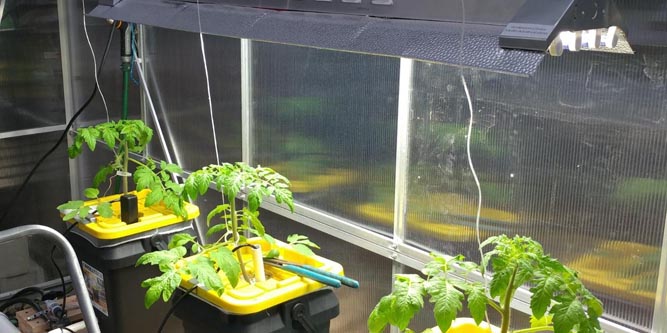Growing plants indoors is no easy task. Whether you’re growing just a few plants or an entire warehouse, achieving the right conditions is critical. This isn’t like growing plants outdoors, where you can throw down a soil monitor and call it a day. This is a complex operation that requires the right balance of temperature, CO2, and humidity. If any one of these factors is off, you’re not going to get an ideal grow. But how do you ensure that you’re getting the best possible balance?
The solution is using a monitoring system. By tracking all of these variables in real time, you’ll be able to take action if there’s any problem. For instance, if your temperature is too high, you’ll want to turn off any heaters. Some monitoring devices even have built-in controllers so your air will be maintained automatically.
Today, we’re going to look at three of the best indoor grow room monitoring devices available. We’ll start by reviewing the Titan Controls Spartan Series Complete Digital Environmental Controller. This is an all-in-one device that senses temperature, CO2, and humidity. It’s also a complete controller that will run your grow room automatically. Next, we’ll check out the Temp Stick. The Temp Stick monitors is a WiFi sensor with remote monitoring, but it only tracks temperature and humidity. Finally, we’ll examine the Autopilot APC8200 CO2 Monitor & Controller. This is a highly advanced monitor/controller unit, but it only handles CO2. Which one is best for you? Let’s dig deeper, and find out!
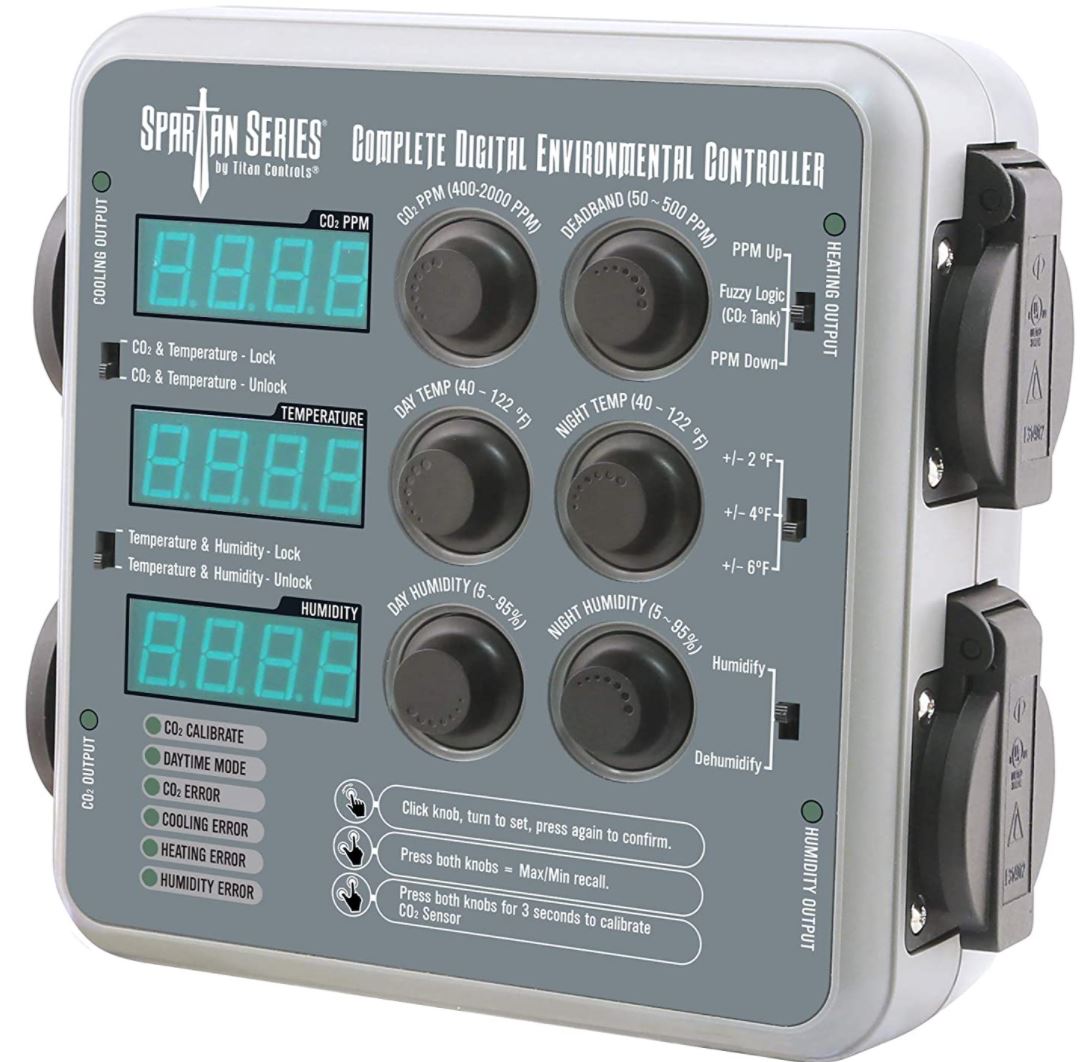
Titan Controls Spartan Series Complete Digital Environmental Controller
The Titan Controls Spartan Series Complete Digital Environmental Controller is a complete, comprehensive unit. It monitors temperature, CO2 levels, and humidity levels. It also controls your heaters, humidifiers, and CO2 dispensers. If you’re trying to set up a fully automated indoor grow, it will get the job done. You’ll just have to stop by periodically to refill your humidifier and CO2 canister. That’s about as convenient as it gets, especially if you’re managing several grows.
The Spartan Series is a two-part unit, consisting of a control station and a remote sensor. The control station itself is big and beefy, measuring 10 inches wide, 10 inches high, and 6 inches deep. At 4.9 pounds, it weighs about as much as a brick, with a rugged polymer casing. It comes with mounting hardware, and takes about fifteen minutes to install.
The sensor is about the size of a computer mouse, with a 15-foot cord to connect to the control station. This allows for easy placement, since the control station doesn’t even need to be inside the grow room. It can be mounted in a utility closet, control room, or anywhere else you please.
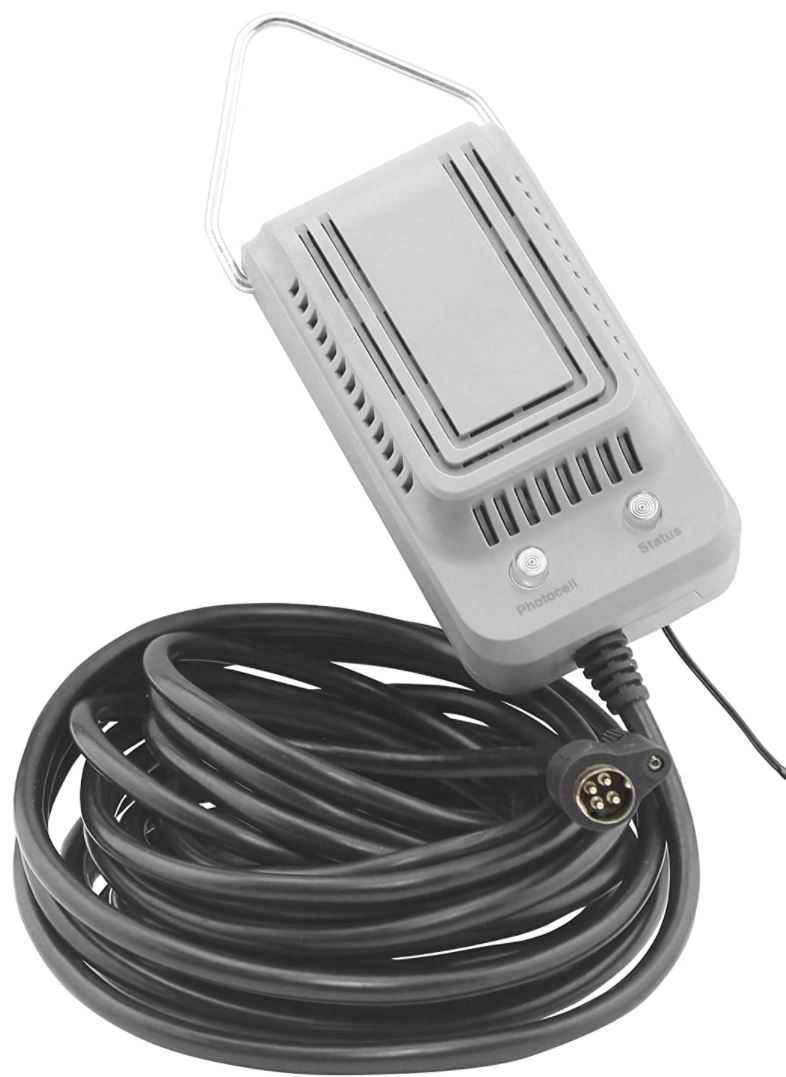
The most attractive feature of the Spartan Series is its fusion of analog controls and a digital display. Along the left side of the control station, three LCD readouts show you your CO2, temperature, and humidity levels. Along the middle, two columns of dials allow you to make your adjustments. The dials must be pressed in order to operate. This prevents accidental adjustments from someone brushing past the dials. Along the right side, there are switches that allow you to make additional adjustments. For example, you can switch easily between a humidifier and a dehumidifier.
Settings and Sensitivity
The Spartan Series allows you to adjust a wide range of CO2, temperature, and humidity settings. For CO2, you get an accuracy of +/- 100 parts per million (PPM). With a range of 400-2,000 PPM, you’ve got plenty of wiggle room to play with. This allows you to maintain a variety of crops through a variety of growing seasons. The dead band is also adjustable. This means the amount the dispensers will release over your target level. Let’s say your PPM is set to 1,000 with a 100 PPM dead band. In that case, your dispensers will run until the CO2 level hits 1,100 PPM.
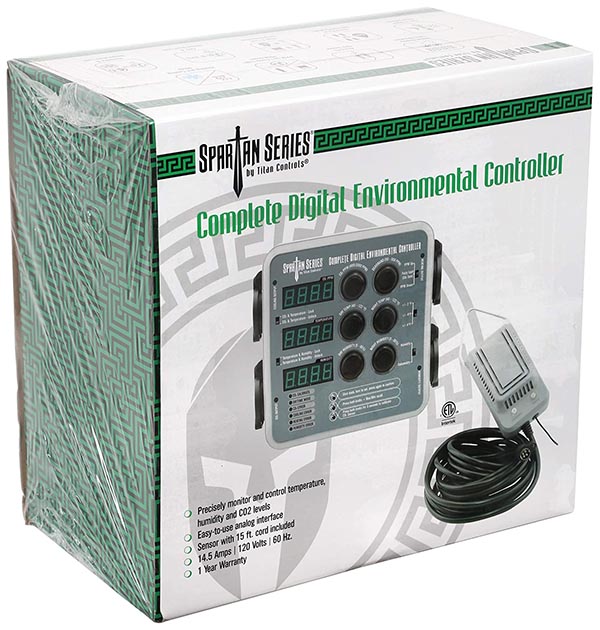
The temperature setting is similarly adjustable. With a range of 40 to 122° F, you can simulate an entire growing season, from spring to fall. This is useful for all-year crops that require a full growing season. The temperature accuracy is within two degrees, so you don’t have to worry about your sensor being off. Even if you set it to 40 and the actual temperature is 38, nothing is going to freeze.
Finally, you get a humidity range of 5 to 95 percent. The controller is compatible with both humidifiers and dehumidifiers depending on your climate and needs. And with an accuracy of 3 percent, you’ll know your plants are getting the right amount of moisture. All of these settings can be programmed on a daily schedule. This way, you can simulate a natural day/night cycle.
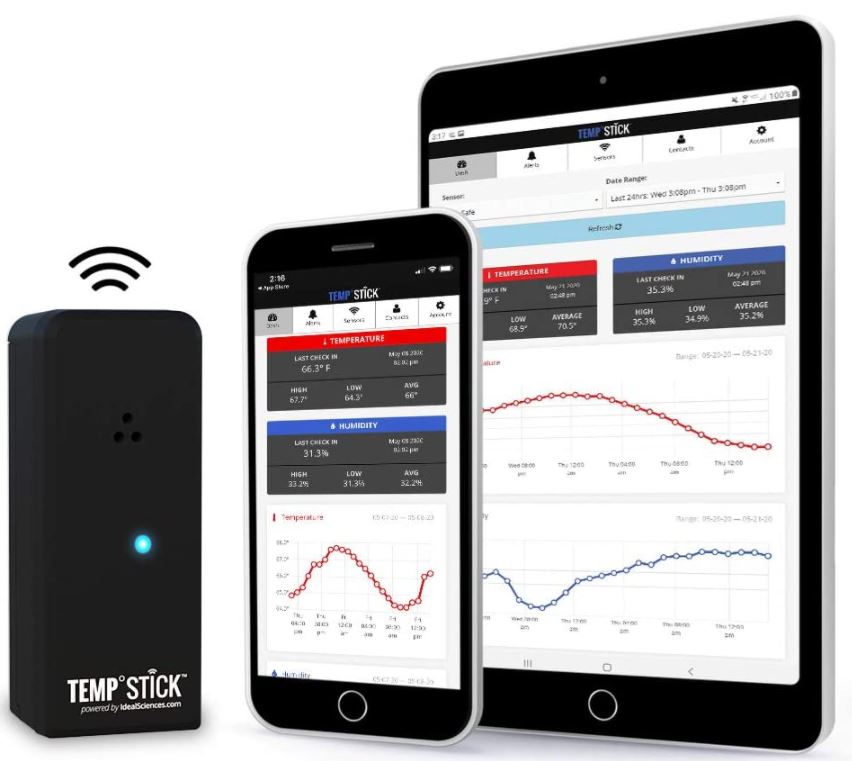
Temp Stick
Where the Spartan Series is an industrial tool, the Temp Stick is primarily designed for residential use. If you’ve got a few racks of hydroponic plants in your spare room, you still need to control the environment. The Temp Stick is a petite unit, measuring just 1.5 inches wide, 1.25 inches deep, and 3.5 inches high. It has an ABS plastic shell, and comes in either black or white. It’s powered by a pair of AA batteries, which makes placement easy since you’re not tethered to a power outlet. The batteries are included with the kit, and will last for about a year. The exact time will depend on temperature and WiFi signal strength. Even so, it’s not something you’ll need to worry about on a day-to-day basis.
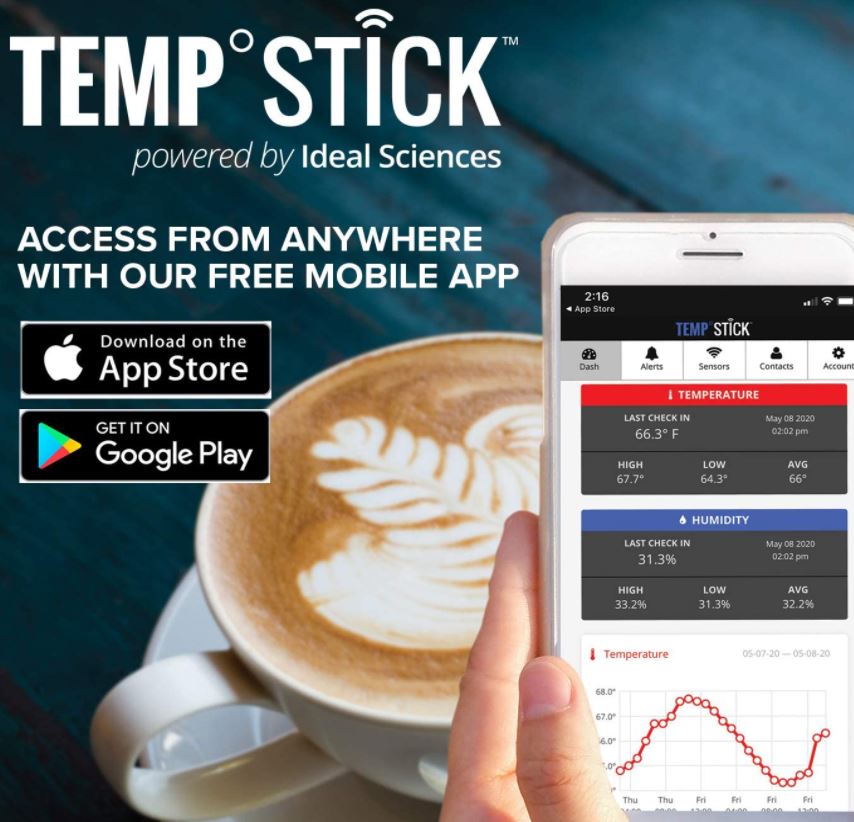
The Temp Stick is a monitor, not a controller. It will let you know if it’s too warm, too cold, too humid, or too dry. However, you’ll have to make any adjustments yourself. You also won’t get any CO2 sensing, but that’s not typically required for home use. Thankfully, the Temp Stick is easy to monitor. It connects to your WiFi network, where it can be accessed from the Ideal Sciences Temp Stick app. The app is free to download on all modern smartphones, both iOS and Android. You can also monitor the Temp Stick via PC or Mac using their web app. This makes it easy to keep track of conditions, no matter where you are. The Temp Stick’s small size also makes it highly versatile. It’s not just for grow rooms. You can monitor a refrigerator, a wine cellar, or a home lager brewing cooler, or any other enclosed space.
The Temp Stick is protected by Idea Sciences’ three-year manufacturer’s warranty. If it fails during this time, simply send it back for a refund or replacement. Idea Sciences also provides phone support seven days a week, so there’s help at hand if you’re having issues.
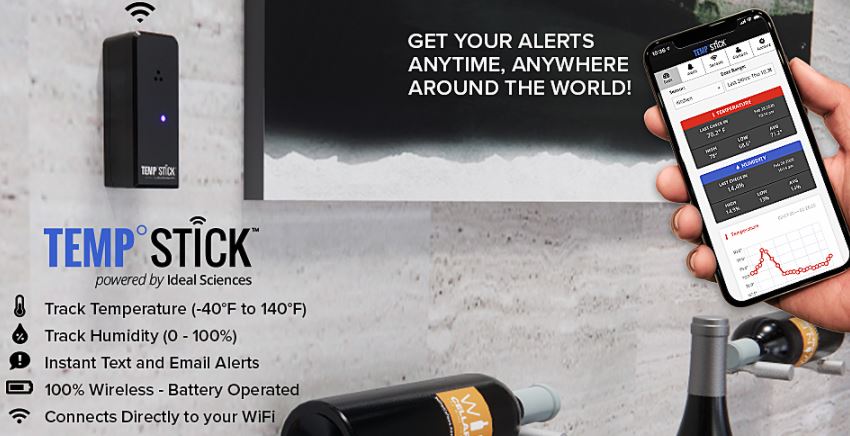
Settings and Sensitivity
In addition to remote monitoring, the Temp Stick also provides text and email alerts. Not only will you get alerts for high or low temperature or humidity. You’ll also get alerts if there’s a low battery, or if the WiFi signal is lost. The app also supports data logging, with an unlimited history. This means you can track conditions over time, and look for patterns of times where there’s trouble. As a result, you might be able to prevent temperature or humidity irregularities before they arise. And unlike with many tracking services, Temp Stick tracking is totally free.
The sensitivity isn’t quite as good as the Spartan Series, but it’s good enough for home use. For one thing, it senses between 0 and 80 percent relative humidity, with 4 percent accuracy. For temperature, it can operate between -40 and 140° F. This makes it comparable to most home thermometers and humidistats. As long as you don’t need CO2 sensing, you’re all set.
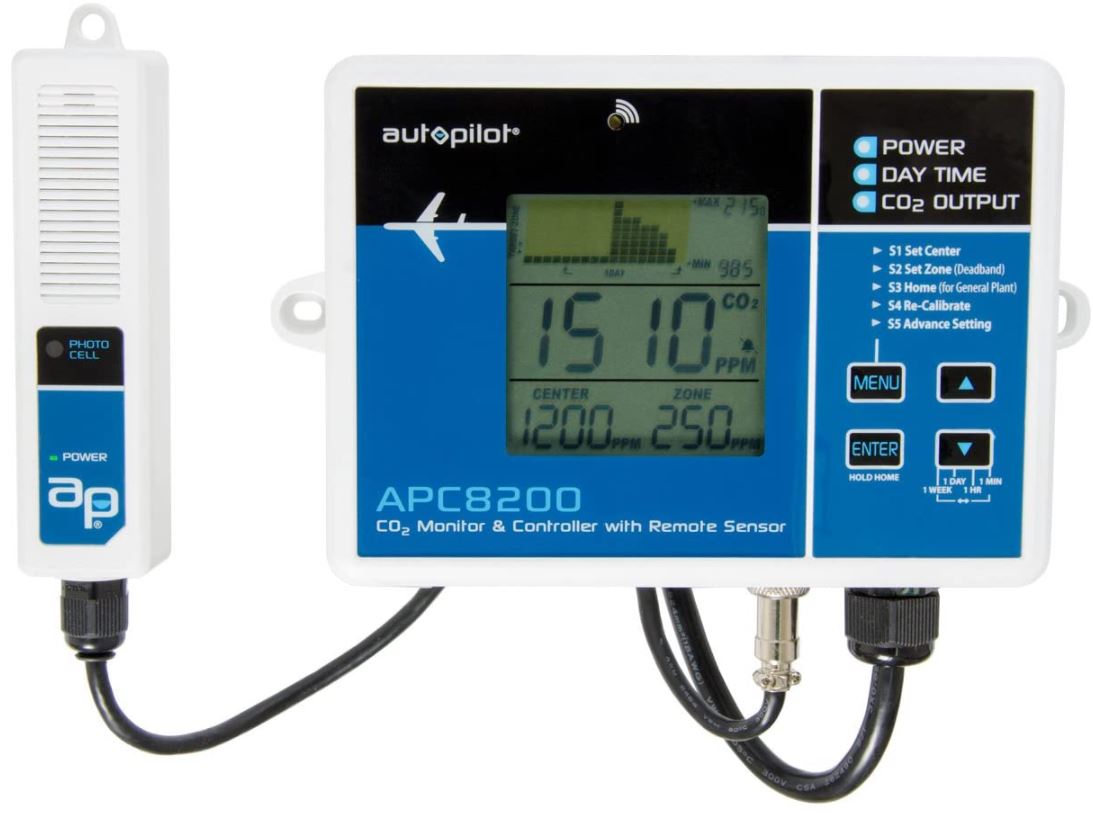
Autopilot APC8200 CO2 Monitor & Controller
The Autopilot APC8200 CO2 Monitor & Controller is the odd man out in our group. Rather than an all-around sensor, it’s a dedicated CO2 monitor/controller. Why might you want something like this? The simple answer is that there are many humidity and temperature controllers available. CO2 controllers, on the other hand, are a bit harder to come by. So if you already have a temperature and humidity controller you like, the Autopilot is an easy add-on.
Like the Spartan Series, the Autopilot consists of a large control station and a smaller sensor. The sensor is connected to the control station by a 15-foot cord, so positioning is easy. The front of the control station sports an easy-to-read digital display. Here, you can adjust all of the Autopilot’s settings. You can adjust the CO2 level, and set a schedule to adjust the level throughout the day. Also like the Spartan Series, the Autopilot has an adjustable dead band.
One thing we really appreciated was the LED display. This gives you a visual of your CO2 levels throughout the day. It’s not as impressive as a smartphone app, but it’s right there on the control station. This makes it easy to monitor at a glance, without the need for WiFi connectivity. The overall size of the control panel is 9.6 inches wide, 7.4 inches high, and 3.4 inches deep. At 2.3 pounds, it’s not terribly heavy. It also comes with mounting hardware, so it’s easy to install.
Autopilot covers the APC8200 CO2 Monitor with a three-year manufacturer’s warranty. It’s already durably designed, but it’s good to know you’re protected if there are any issues.
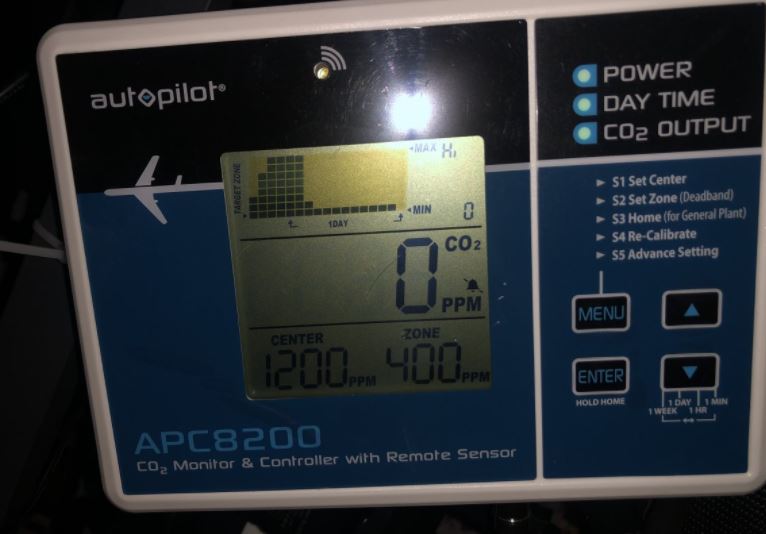
Settings and Sensitivity
The Autopilot uses an advanced 2-channel low drift NDIR sensor to read CO2 levels. This is an infrared spectrometer that detects CO2 PPM levels with extreme accuracy. This makes the Autopilot suitable for applications where more than 10 PPM inaccuracy can cause trouble.
Along with an adjustable dead band, the Autopilot sports an adjustable tracker. You can track periods as long as 7 days, or as short as a few minutes. This adjustable trend chart makes the Autopilot highly versatile. You can track weekly trends to look at the big picture, or track minute-to-minute trends for precision applications. As a result, the Autopilot is useful for home chemists, amateur brewmasters, and many others. Grow rooms are only the beginning of what it can handle.
Final Verdict
So, how do these devices all stack up? Let’s quickly recap what we’ve learned. The Titan Controls Spartan Series Complete Digital Environmental Controller is best for commercial use. If you’ve got heaters, humidifiers, and CO2 dispensers that work with a controller, it’s fully automatic. Of course, obtaining all that equipment could be prohibitively expensive for a small home grower. But if you expect to earn money from your grow, the investment will pay off in spades. Not only that, but the analog interface is simple, straightforward, and intuitive.
The Temp Stick is a better option for home grows. On the downside, it’s a sensor, not a controller. You’ll need to make any adjustments manually. On the upside, it’s very affordable, and you don’t have to invest in any extras. As an added bonus, the Temp Stick is WiFi-enabled, so you can get alerts anytime, anywhere. This isn’t ideal for a commercial operation where every minute counts. But if you’re a casual indoor gardener, that kind of pinpoint accuracy isn’t necessary. If the air is three degrees too warm for a few hours, your plants aren’t going to die. You also won’t miss the CO2 sensing, which isn’t typically required for home grows.
Last but not least, we looked at the Autopilot APC8200 CO2 Monitor & Controller. Unlike the first two devices we looked at, the Autopilot doesn’t monitor temperature or humidity. It’s strictly a CO2 monitor. That said, it does have a built-in controller so you can automate your system. It also has nifty features like logging and a customizable dead band for even more personalization. If you’re looking for the king of CO2 controllers, the Autopilot is tough to beat.
Meet Ry, “TechGuru,” a 36-year-old technology enthusiast with a deep passion for tech innovations. With extensive experience, he specializes in gaming hardware and software, and has expertise in gadgets, custom PCs, and audio.
Besides writing about tech and reviewing new products, he enjoys traveling, hiking, and photography. Committed to keeping up with the latest industry trends, he aims to guide readers in making informed tech decisions.

